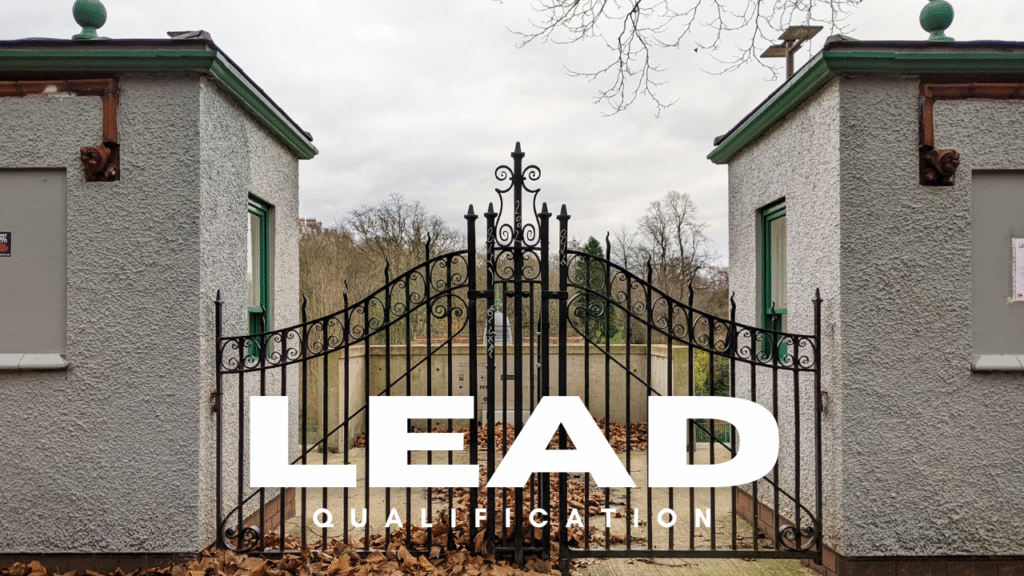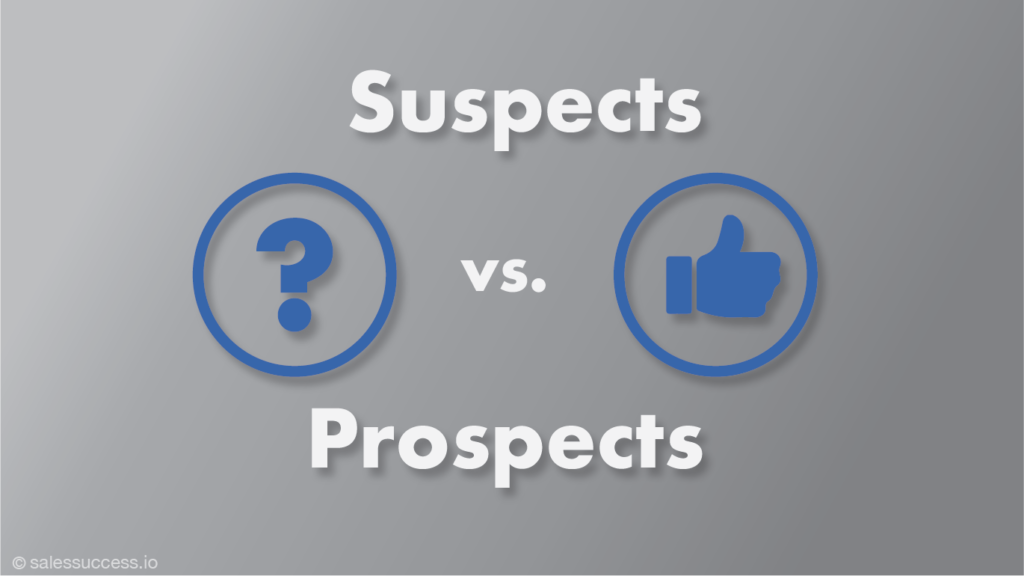- BDR vs. SR: Understanding the Sales Roles and Division of Labor
- Handling Objections: A Guide to Overcoming Customer Concerns
- Making Presentation: Tips for a Compelling and Engaging Delivery
- Qualifying Prospect: The Key to Sales Success
- Setting Appointment: Strategies and Tips for Successful Sales Calls
- Closing Sales: 44 Techniques and the Steps for a Successful Close
- Prospecting for Leads: Finding Your Next Customers
- Sales Process or Cycle: The 7 Steps to Sales Success (and How the Sales Process in Salesforce Works)
- The Iron Gate of Sales: Hard Lead Qualification is Critical
![]()
In sales, the pressure to fill the pipeline is constant. It’s tempting to embrace every inquiry as a potential deal. But for companies dealing with complex, custom, or infrastructure-heavy projects—such as Internet Service Providers (ISPs), custom software developers, construction firms, or specialized manufacturers—this “quantity over quality” approach is a recipe for silent financial bleeding.
The truth is, not all leads are created equal. Some are genuine opportunities waiting for a solution; others are merely curiosity, tire-kicking, or a project doomed to fail. This is why hard lead qualification is not a negotiable step; it is the fundamental mechanism that protects your most valuable and scarce resources: your people, their time, and your business margin.
Hard qualification acts as an “Iron Gate” into your business. It ensures that when you do engage deeply with your most expensive validation processes—like commissioning a full ISP feasibility check (which is itself the final, crucial qualification stage)—you are doing it for opportunities that have already passed initial commercial, budgetary, and strategic gates and are not only technically feasible but also economically sane and strategically aligned. It is how your company decides which “possible projects” deserve real investment of time, money, and attention, and which ones should be politely parked or declined.
The Cost of Unqualified Enthusiasm: Why Hard Qualification is Necessary
For industries engaged in intricate, high-cost pre-sales work, every serious opportunity triggers an expensive chain reaction. Consider the resources consumed:
- Engineering Hours: Network design, site surveys, custom solution architecture, or calculating bill of materials.
- Financial & Legal Time: Detailed pricing models, contract drafting, and sometimes regulatory checks.
- Opportunity Cost: The high-value work your best teams could have been doing on a sure-bet deal instead of a speculative one.
If these expensive efforts are invested in leads that ultimately lack the budget, the necessary authority, a real operational need, or technical feasibility, the business silently hemorrhages margin long before a contract is ever signed.
Lead qualification acts as the critical gate: It is a tiered process. Only opportunities that clear basic, non-negotiable viability thresholds (budget, urgency, ICP fit) move on to the heavy, resource-intensive qualification steps, such as a detailed technical feasibility study or a full proposal. This prevents your engineers, solution architects, and project teams from being turned into unpaid consultants for prospects who are not realistically going to buy.
Financial Risk Management: Turning Speculation into Underwriting
Unqualified leads are more than just “unlikely revenue”; they represent hidden, sinking costs. Running a feasibility study for a circuit that will never be ordered is a sunk cost of engineering time, an opportunity cost for the projects that were sidelined, and often includes external spend on vendors, permits, or surveys.
By qualifying for both technical feasibility and commercial viability—for an ISP, this might be confirming the minimum monthly recurring revenue (MRR) justifies the build cost and payback period—companies avoid committing to projects that will never reach break-even.
In portfolio terms, qualification is how a sales organization manages its risk–return profile. It allows the business to trade in fewer speculative “lottery tickets” for more well-underwritten, profitable bets. This discipline ensures that your capital is deployed only into projects with a defined, positive path to return on investment (ROI).
Efficient Use of Finite Resources
Sales teams can only deeply work a limited number of deals at any given time, and engineering teams can only run so many designs and feasibility assessments in parallel. This is especially true for highly skilled, specialized talent.
Qualification ensures those finite cycles are allocated to the leads with the highest probability and value, instead of being consumed by low-priority inquiries or “nice to have” projects.
- For an ISP: Qualification means confirming basic fit (serviceable area, rough build cost range, minimum contract term) before commissioning a full, detailed network design.
- In B2B more broadly: It means checking for budget, key decision-makers, urgency, and the core problem-solution fit early, ensuring the pipeline isn’t clogged with “zombie deals” that will stall for non-technical or financial reasons.
Layered Qualification: The MEDDIC+ Technical Framework
For complex technical and ISP-style sales, lead qualification needs structure. It must move beyond basic BANT (Budget, Authority, Need, Timeline) into a layered framework that checks fit, feasibility, and deal viability in a consistent, repeatable way. A practical approach is to adapt an enterprise framework like MEDDIC, then add explicit technical feasibility and delivery economics criteria.
Step 1: Define Your “Must-Have” Profile
Before discussing individual questions, you must define what a truly qualified lead looks like for your business. These are the non-negotiable guardrails:
- Ideal Customer Profile (ICP): Industry, size, geography, typical use cases, and technical maturity.
- Deal Parameters: Minimum contract value (MCV), minimum term length, acceptable payback period, and strategic fit (e.g., target build-out regions for an ISP).
If a lead falls outside these “must-have” criteria, the bar for progressing to the next stage should be exceptionally high, requiring senior exception.
Step 2: Use a Core Framework (MEDDIC)
For complex, multi-stakeholder sales, use a structured framework like MEDDIC, adapting the wording to your field:
- Metrics: Quantifiable business impact (e.g., cost savings, latency reduction, operational efficiency).
- Economic Buyer: Who ultimately owns and controls the budget.
- Decision Criteria: The objective technical, commercial, and compliance must-haves the solution will be judged against.
- Decision Process: The formal steps, approvers, and procurement path.
- Identified Pain: Concrete operational or business problems your solution is solving (not vague interest).
- Champion: An internal advocate with influence and a vested interest in your success.
Require at least a basic answer in each block before committing any pre-sales resources.
Step 3: Add Explicit Technical Feasibility Criteria
For deep technical sales like ISPs, this is the most critical addition. A separate “Technical Feasibility” section must be checked early, before full design or site survey. (Note: While the full, costly feasibility study is often the deepest and final stage of qualification itself, this early step acts as a ‘pre-feasibility’ gate to ensure the project is not fundamentally impossible.)
- Environment & Integration Fit: Is the location serviceable? Does it integrate with the customer’s existing tech stack, network, and security infrastructure via supported protocols?
- Constraints: Can we meet the performance, redundancy, security, and compliance demands within a realistic scope?
- Resource and Risk View: Are there any hard blockers, impossible latency targets, or major technical risks that would render the project impractical, regardless of budget?
This assessment should result in a clear, unambiguous outcome (e.g., Green/Amber/Red) to quickly filter out infeasible projects.
Step 4: Capture Commercial and Delivery Viability
Technical feasibility alone is insufficient. You must confirm the project’s economics and operational fit:
- Budget Alignment: Is the confirmed budget range aligned with your cost to serve and minimum margin requirements?
- Priority and Timing: Does the initiative have high enough priority to be completed this year? What is the cost of delay (urgency)?
- Delivery Constraints: Are the proposed timelines, internal capacity, and external dependencies (e.g., third-party permits) realistic?
For a new circuit build, a rule that ties minimum MRR to the build cost acts as a crucial gate, preventing sales from progressing a technically feasible but financially bad deal.
The Power of “Must-Haves” vs. “Nice-to-Haves”
To simplify day-to-day use, categorize your qualification attributes:
| Must-Have Attributes (Pass/Fail Gates) | Nice-to-Have Attributes (Score Boosters) |
| Clear problem/pain your solution solves. | Strong internal Champion with executive access. |
| Customer fit with your Ideal Customer Profile. | High urgency or a compelling, near-term event. |
| Confirmable budget and plausible funding path. | Strategic value (e.g., “lighthouse” logo, new market entry). |
| Identified decision-maker(s) and a defined buying process. | Multi-year commitment or strong expansion potential. |
| Technical feasibility at a high level. | Low competitive intensity or clear preference for your solution. |
| Minimum deal economics (margin, payback period). | Operational “easy mode” factors (e.g., mature team, clean data). |
Every deal must pass all Must-Haves to stay in the active pipeline. Nice-to-Haves are used to prioritize which qualified deals receive the most senior attention and resources.
Better Customer and Seller Experience
The final, often overlooked benefit of hard qualification is the profound impact it has on the customer and seller experience.
- For the Customer: When leads are well-qualified, conversations are more relevant, timelines are clearer, and expectations are realistic from the start. Customers are not dragged through long, confusing discovery and design cycles only to learn at the end that the price, scope, or timeline is fundamentally unacceptable.
- For the Sales Team: It translates into less frustration from deals that die late due to predictable issues (no budget, wrong fit, no urgency) that could have been surfaced early. The pipeline becomes more honest: fewer “zombie deals” lingering at proposal stages with no real path to closure.
Strategic Focus and Learning
Consistent, structured lead qualification creates structured data about who actually buys and why, rather than just who inquires. Over time, that feedback refines the Ideal Customer Profile, informs pricing and packaging, and guides where marketing and outbound efforts should concentrate.
In the ISP context, patterns in disqualified requests inform which geographies, building types, or customer segments should be targeted with proactive build-outs or special offers. Qualification thus becomes not only an efficiency mechanism but also a strategic sensing tool that shapes your product and network investment decisions.
Conclusion
Hard lead qualification is crucial because it decides which of your many inquiries deserve your most expensive effort—protecting your margins, focusing your specialized teams on the right opportunities, and ensuring that both your company and your customer only invest heavily when there is a real, winnable, and profitable deal on the table.
Subscribe to our Blog



